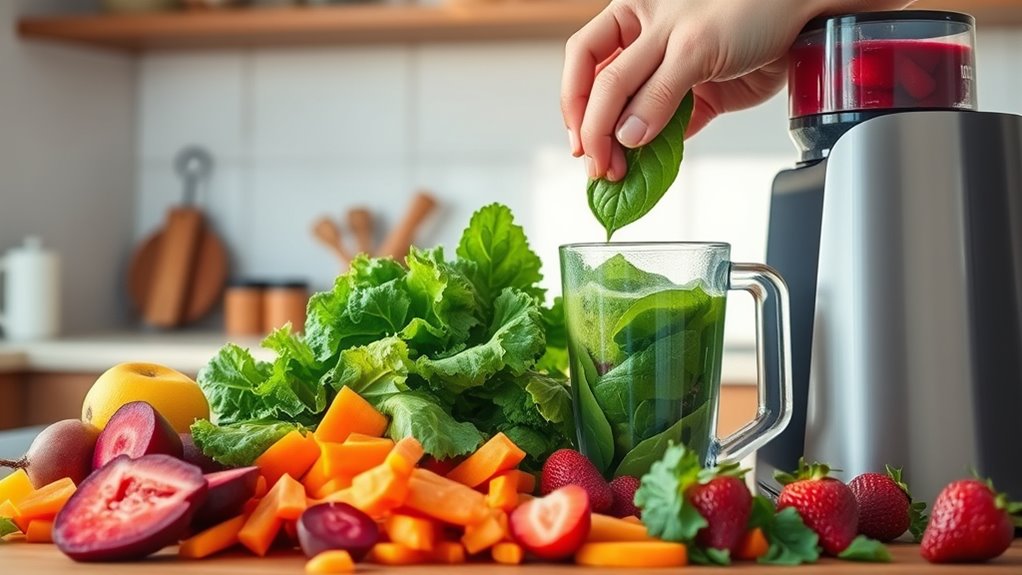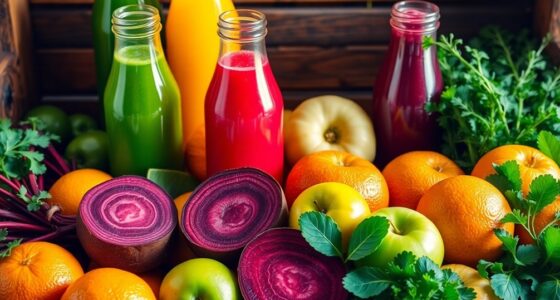Moving to organic juicing at home is simple and rewarding. Start by selecting a reliable juicer suited to your lifestyle and budget, then choose fresh, seasonal organic produce for the best flavor and nutrients. Properly clean and handle your ingredients, and store your produce correctly to maximize freshness. Consistent maintenance of your equipment and experimenting with different combinations help create enjoyable, nutrient-rich juices. Keep going, and you’ll discover even more ways to boost your health and sustainability through organic juicing.
Key Takeaways
- Select a reliable, easy-to-clean juicer that suits your lifestyle and budget for consistent use.
- Prioritize organic, seasonal produce from trusted sources to maximize flavor and nutrient content.
- Thoroughly wash all fruits and vegetables to ensure purity, even if organic.
- Store produce properly and maintain your equipment regularly for freshness and hygiene.
- Develop favorite juice recipes to integrate organic juicing into your daily health routine.

Starting your own organic juicing at home is an easy way to boost your health and enjoy fresh, nutrient-rich drinks anytime. The first step is choosing the right juicing equipment. You’ll want a reliable juicer that fits your lifestyle and budget. Options range from centrifugal juicers, which are fast and easy to clean, to masticating juicers that extract more nutrients and handle leafy greens better. Investing in quality juicing equipment ensures you get the most juice and nutrients from your produce without frustration. Make sure your juicer is durable, easy to operate, and easy to clean, so juicing becomes a regular part of your routine rather than a chore. Once you have your equipment, the next critical step is organic produce selection. Opt for fresh, seasonal fruits and vegetables labeled as organic. Organic produce is grown without synthetic pesticides, herbicides, or genetically modified organisms, making your juice healthier and free from harmful residues. When shopping, look for local farmers markets or organic sections in grocery stores for the best quality. Prioritize vibrant, firm produce that shows no signs of spoilage, bruising, or wilting. The flavor and nutrient content of your juice depend heavily on the quality of your ingredients. Wash everything thoroughly to remove any dirt or residual pesticides, even if labeled organic, to make your juice as clean as possible. Incorporate a variety of produce to maximize nutrient intake and keep your juices interesting. Leafy greens like kale and spinach add vital minerals, while carrots, beets, and apples contribute natural sweetness and antioxidants. Experiment with different combinations to discover what tastes best and provides the most health benefits. As you transition to organic juicing at home, remember that consistency is key. Keep your juicing equipment clean by rinsing and sanitizing after each use to prevent mold and bacteria growth. Store your organic produce properly—usually in a crisper drawer or cool, dark place—to maintain freshness. Incorporate seasonal produce to support local growers and enjoy the freshest flavors. Additionally, choosing natural materials for your kitchen tools and storage containers can further enhance the purity of your juice and support eco-friendly practices. Over time, you’ll develop your favorite recipes and refine your process, making organic juicing a sustainable, enjoyable habit. The effort you put into selecting quality equipment and produce pays off, giving you delicious, nutrient-dense drinks that support your wellness goals. Transitioning to organic juicing isn’t just about health; it’s about creating a nourishing ritual that benefits your body and supports sustainable farming practices. With the right tools and fresh ingredients, you’re set to enjoy the many advantages of homemade organic juice every day.
Frequently Asked Questions
How Do I Choose the Best Organic Fruits and Vegetables for Juicing?
You should look for organic produce labels that certify the fruits and vegetables are truly organic. Focus on seasonal buying to get the freshest, most flavorful options, as seasonal produce tends to be higher in nutrients and taste. When selecting, inspect for firmness, vibrant color, and minimal blemishes. Combining certified labels with seasonal choices guarantees you get the best quality organic produce for your juicing, maximizing flavor and health benefits.
What Are Common Mistakes to Avoid When Starting Organic Juicing?
You might overlook essential mistakes when starting organic juicing, like overharvesting produce, which leaves less for future use, or neglecting to wash produce thoroughly, risking contaminants. Picture a vibrant, fresh juice, only to realize dirt or pesticides linger. Avoid these pitfalls by harvesting responsibly and washing everything meticulously. Pay attention to these details, and your juices will be safer, tastier, and more nourishing, making your organic journey a true success.
How Can I Store Organic Juices to Maintain Freshness?
To keep your organic juices fresh, use airtight storage containers, preferably glass ones, to prevent oxidation. Store them in the refrigerator and fill containers to the top, reducing air exposure. Always refrigerate promptly after juicing and consume within 24-48 hours. Follow refrigeration tips like avoiding door storage, which exposes juices to temperature fluctuations. This way, your juices stay flavorful, nutritious, and fresh for longer.
Are There Specific Organic Produce Seasons for Juicing?
You’ll find the freshest organic produce during seasonal harvests, when vibrant fruits and vegetables burst with flavor. Spring and summer bring sweet berries, crisp cucumbers, and juicy tomatoes, perfect for energizing your juices. Fall offers hearty apples and root vegetables, while winter supplies hardy greens and citrus. By aligning your juicing with these organic harvests, you enjoy peak freshness, maximizing flavor and nutritional benefits in every glass.
What Equipment Is Essential for a Beginner’s Organic Juicing Setup?
You’ll need a good quality juicer, like a masticating or centrifugal one, to start with. Invest in a few essential tools such as a cutting board, sharp knives, and a cleaning brush to make cleaning tips easier. With these, you can experiment with various juicing recipes, ensuring your equipment stays hygienic. This setup helps you enjoy fresh, organic juice every day while keeping your juicer in top shape.
Conclusion
As you embrace organic juicing at home, you’re opening the door to a garden of vibrant flavors and nourishing treasures. Think of your kitchen as a sanctuary where fresh fruits and veggies dance together, creating a symphony of health in every glass. With each sip, you’re watering the roots of your well-being and harvesting the purest essence of nature. So, keep blending, experimenting, and savoring—you’re crafting a colorful, delicious masterpiece in every glass.










